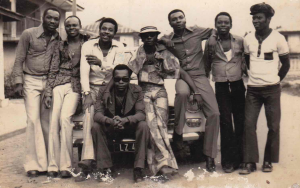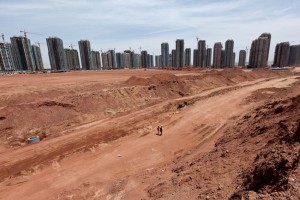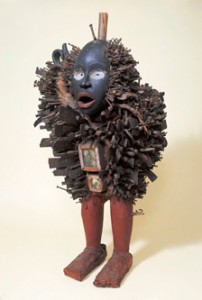
Flat whites on Bellenden Road
by Fintan Calpin | January 6, 2016
“Since 2008.” Rammie, who owns a shop and fruit stand under the arches on Rye Lane, gives me a precise timeframe for when Peckham’s property prices became an issue.
I’ve been coming regularly to Peckham, from my home in neighbouring East Dulwich, for all twenty years of my life. Peckham is an area of south-east London known for its longstanding working-class population and cultural diversity, notably becoming home to a new migrant population following the Windrush and postwar immigration in the ’50s, and today the majority of its population is Black African or Black Caribbean, as well as comparatively high Chinese, Bangladeshi and other Asian populations. As I’ve grown up, I’ve seen it from different perspectives. When I was much smaller, accompanying my parents round the markets, Peckham was the smell of fish, fruits I couldn’t reach, and on the best days blurry, knee-high views of the inside of Woolworths for popcorn and coke, followed by the sticky floors of the Multiplex for the latest Pixar. Later, my parents opened a savings account for me in the Nationwide on Rye Lane and I remember long queues out the door there, but it closed permanently in 2011. It was also in 2011 that my friends started talking about going to Frank’s Cafe on the roof of the car park behind the cinema, with its cool promise of an open air bar and art installations. Peckham was now a good place to go for everyone, a change that had happened synchronously with me getting old enough to go out and drink. My friends would come from across London to go to the Bussey Building, a trendy and increasingly popular nightclub and arts centre. Bellenden Road, which to me had always just been a thoroughfare onto the main Rye Lane, became a place for coffee and dinner. I spent my last summer evenings before university nursing whisky sours in the desperately trendy Peckham Springs, a bar frequented by a generation of young artists and professionals new to Peckham and tucked behind the arches of Peckham Rye station, between the metalworks and mechanics that have been there forever.
I’m back a year later on a Saturday in mid-July. Yuppies pile off the Overground from East London and filter into the bar underneath. My friend remarks that there are “a fuck lot more T.M. Lewin shirts and shit V-neck jumpers” than the last time we came. We talk briefly and inconclusively about gentrification, mostly regarding how the cocktails used to be cheaper and more alcoholic. I wonder quietly if I’m gentry.
Earlier that day I’d been wandering up Rye Lane when I asked Rammie if I could speak to him about gentrification in Peckham. He shrugged, said he wasn’t busy, and invited me into his shop. Rammie has lived and worked here for about twenty years, but the biggest change, he told me, has come in the last seven. He says the area has ‘cleaned up’ and crime has gone down, but it has become significantly worse for business, largely thanks to the increasing rent prices. He reckons that property prices have doubled since 2013. When I Google this, later, I see he’s not exaggerating, but the facts beggar belief. The rent he pays for his shop has gone up dramatically since 2008. I remember that Frank’s Cafe opened that year. “Peckham has a different mentality now,” he says. Considering the way it’s going for businesses like his, I ask him if he plans on staying in Peckham. He shakes his head and mentions plans to move to Bromley, further out into London’s more affordable suburbs.
After talking to Rammie I walk up and down the lane, perusing the shops and market stalls. Much of Peckham seems unchanged—the fresh fishmongers and butchers, those great stands of fruits and vegetables, Asian and African minimarts, the barbers by the station. I walk past two guys sat next to an enormous speaker playing dub, and chat briefly to the owner of a West African clothes store in the indoor market. It is different, though: I’m more aware of that unassuming archway between a butcher’s and newsagents leading to the Bussey building, and can’t help but notice the trendy white kids slipping down past the Multiplex towards Frank’s as the evening gathers near. Trying to put my finger on exactly what Rammie meant about Peckham’s changing mentality, I try to keep in sight two different views of Peckham, one of its arty bars and cool clubs, another of its well-established community and culture.
Going down a street perpendicular to Rye Lane I come to Bellenden Road. With its indie shops and trendy restaurants, this is the face of gentrified Peckham. Gastropubs here charge between ten and seventeen pounds for a main, and you’d be hard pressed to find a pint under four pounds. There’s a giant mural on the wall of a pub that was almost certainly commissioned. It’s a gesture towards an urban aesthetic, echoing the graffiti coating the nearby train lines and hard-to-reach places of Rye Lane. It’s clear how the longstanding culture and character of the area has influenced the aesthetics of gentrification here. But the difference is palpable: this is Street Art with a capital ‘A’. When money and commercial demand meet the cultural expression of a minority group, it’s hard not to think about appropriation. The ‘regeneration’ of an area in the process of gentrification seizes on a notion of ‘decay’—ironically, it renews this ‘run-down’ aesthetic. Given the narrative of ‘improvement’ that this development implies, it’s worth noting how the language of colonialism is present in the way we talk about ‘up-and-coming’ areas like Peckham. Lifestyle articles talk about ‘discovering’ them, and in doing so write out the communities that existed there before. Peckham has always been there, but it’s been working class and black.
When I ask someone working on Bellenden Road if they’ve noticed any changes in Peckham since they’ve been here, she says, “Yes, more racist attacks.” She’s seen young, rich, white kids chasing a black man down the road, shouting “You don’t own Peckham anymore.” There’s an influx of moneyed white people entering this area—the incoming population ‘discovering’ Peckham—and a growth in violence against its longstanding communities. She tells me that the gentrification we’re seeing here is just a semiotic factor, a symptom of rampant free-market forces. Peckham’s problem isn’t just one of property prices, but of practised social cleansing.
It’s true that the problem is bigger than new businesses taking advantage of increased demand and setting up niche, upmarket shops in trendy areas, as the viral defence of Shoreditch’s Cereal Killer Café in an open letter from its proprietor insisted. But this doesn’t shift responsibility entirely. I do understand and support the recent protest in Shoreditch that targeted the café as a symbol of gentrification, if only because by targeting a symbol we can draw attention to the issues of which it is symbolic. Integration is key, and small businesses have to be careful to support the local economy, not siphon money away from it and price out its people. It is a very dangerous assumption indeed to think that sipping a flat white on Bellenden Road is a politically neutral action.
I end my evening in Peckham drunk at the Bussey Building. It is full of middle-class accents dressed in working-class clothes. The whole urban, edgy thing wears thin as I sober up, staring confusedly at my Reebok Classics in the smoking area. I imagine gentrification drinking Peckham dry and in its place offering up a flat white with some graffiti on the side of the cup. I conclude that I am socially conscientious but part-complicit in gentrification and experience self-loathing. Next time I come to Peckham I will shop at Rammie’s store. Hopefully he will still be there.
Image by alainalele




